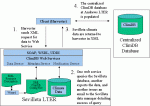SDSC scientists and several LTER information managers are collaborating on a demonstration project exploring how ClimDB, the cross-site LTER climate database, may be implemented in a web services architecture. This project illustrates how the LTER information management community is building links with partners who have the expertise to guide the integration of new technologies into the Network Information System (NIS).
ClimDB is housed at the Andrews LTER site and is administered by Don Henshaw (Andrews LTER Information Manager). Currently, information managers at each LTER site manipulate their data into the specific ClimDB format and manually trigger a data harvest via the internet, a system which is neither scalable nor extensible. Based on discussions with Peter Arzberger, Chaitan Baru, and Tony Fountain following the LTER Information Manager Executive Committee meeting at SDSC in February 2002, a plan to use ClimDB to demonstrate how web service technology could facilitate the development of a scalable and extensible data harvesting mechanism for NIS modules was initiated.
Web services will provide a new data harvesting mechanism, although the ClimDB database itself will remain unchanged. Web services are software that are exposed to other software over Internet-friendly protocols, and which allow one computer application to interact with another without human intervention (Figure 1). The harvester does not have to know about the underlying structure of the data; all it needs to know is that a web service that provides ClimDB data is available from the Sevilleta. Eventually, this system will incorporate EML, a structured metadata language based on XML that all LTER sites are adopting, to provide details about what data is available, how it is structured, and how to query it.
The project was kicked off in May 2002 with a planning meeting at SDSC attended by information managers and programmers from some LTER sites serving as test locations: Peter McCartney and Robin Schoeninger (CAP), Don Henshaw and Kyle Kotwica (AND) and Kristin Vanderbilt (SEV). Since that time, progress has been swift. Longjiang Ding, SDSC programmer, first successfully created web services for North Temperate Lakes LTER’s Oracle database, with assistance from Barbara Benson and Dave Balsiger. Andrews LTER’s SQL Server database and the Sevilleta’s flat file data have also been wrapped by web services.
Ultimately, the objective of this project is to produce a data harvesting mechanism that will facilitate easy addition of a new site to a NIS module, or addition of new NIS services to an existing site. This partnership between SDSC and the LTER is expected to contribute to more rapid development of NIS modules to enhance opportunities for cross-site synthetic research. This work was supported NSF Grant DEB-9634135 to LTER Network Office.

 Enlarge this image
Enlarge this image